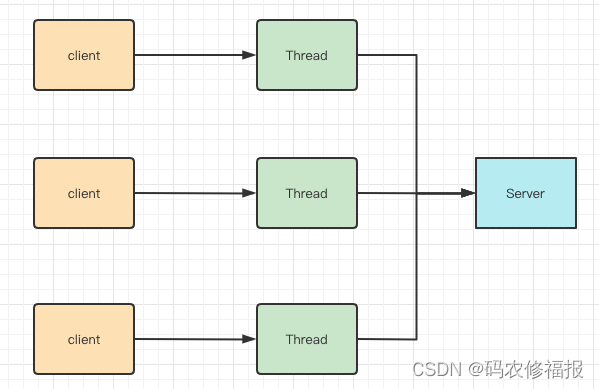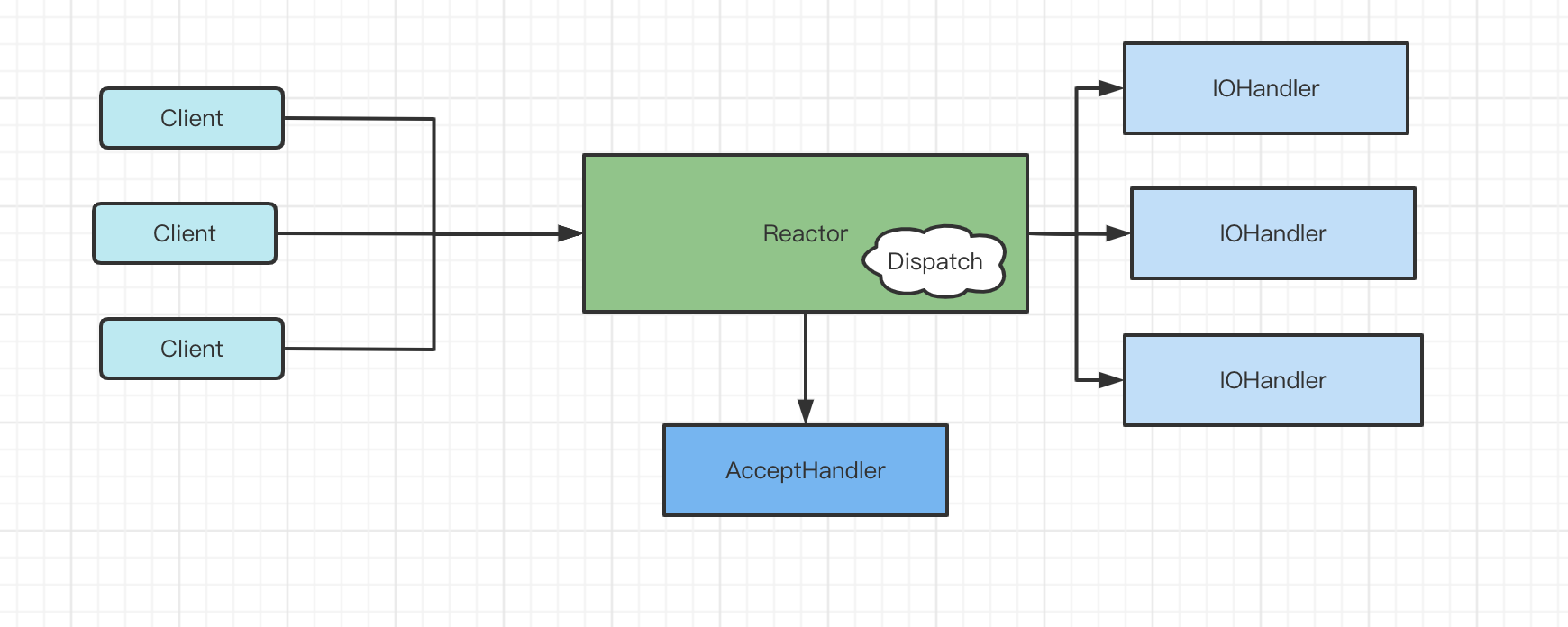目录
IO模型就是说用什么样的通道进行数据的发送和接收,首先要明确一点:IO是操作系统与其他网络进行数据交互,JDK底层并没有实现IO,而是对操作系统内核函数做的一个封装,IO代码进入底层其实都是native形式的。Java共支持3种网络编程IO模式:BIO,NIO,AIO
一、同步阻塞IO
同步阻塞IO也成为BIO(Blocking IO),是指用户线程发起IO,需要等待系统内核IO操作彻底完成才能返回到用户线程继续执行;在IO操作过程中,用户线程处于阻塞状态;这就是为什么成为阻塞IO的原因.

BIO缺点
- 如果BIO使用单线程接受连接,则会阻塞其他连接,效率较低。如果使用多线程虽然减弱了单线程带来的影响,但当有大并发进来时,会导致服务器线程太多,压力太大而崩溃。
- 多线程也会有线程切换带来的消耗,高并发场景下性能差
示例代码
/**
* BIO代码中连接事件和读写数据事件都是阻塞的,所以这种模式的缺点非常的明显
*
* 1、如果我们连接完成以后,不做读写数据操作会导致线程阻塞,浪费资源
*
* 2、如果没来一个连接我们都需要启动一个线程处理,那么会导致服务器线程太多,压力太大,比如C10K;
*
*/
public class SocketServer {
public static void main(String[] args) throws IOException {
ServerSocket serverSocket = new ServerSocket(9000);
while (true) {
System.out.println("wait....");
//BIO 阻塞等待链接
Socket accept = serverSocket.accept();
System.out.println("handle request");
new Thread(() -> {
try {
handleRequest(accept);
} catch (Exception e) {
}
}).start();
}
}
private static void handleRequest(Socket clientSocket) throws Exception {
byte[] bytes = new byte[1024];
System.out.println("prepare read.....");
int read = clientSocket.getInputStream().read(bytes);
System.out.println("read end...");
if (read != -1) {
System.out.println("receive client request is " + new String(bytes, 0, read));
}
clientSocket.getOutputStream().write("hello".getBytes());
clientSocket.getOutputStream().flush();
}
}
public class SocketClient {
public static void main(String[] args) throws Exception {
Socket socket = new Socket("localhost", 9000);
socket.getOutputStream().write("hello".getBytes());
socket.getOutputStream().flush();
System.out.println("send request end ..");
byte[] bytes = new byte[1024];
int read = socket.getInputStream().read(bytes);
System.out.println(" response is " + new String(bytes));
socket.close();
}
}
二、同步非阻塞IO
为了解决BIO问题,在JDK1.4引入同步非阻塞IO也称为NIO(Non-Blocking IO),是指用户线程发起IO操作时不会处于阻塞状态。
NIO的多路复用底层主要用的是Linux 内核函数(select,poll,epoll)来实现的。windows不支持epoll实现,windows底层是基于winsock2的select函数实现的(不开源)。三种内核模型的区别如下所示!
| select | poll | epoll(jdk 1.5及以上) | |
| 操作方式 | 遍历 | 遍历 | 回调 |
| 底层实现数组 | 数组 | 链表 | 哈希表 |
| IO效率 | 每次调用都进行线性遍历,时间复杂度为O(n) | 每次调用都进行线性遍历,时间复杂度为O(n) | 事件通知方式,每当有IO事件就绪,系统注册的回调函数就会被调用,时间复杂度O(1) |
| 最大连接 | 有上限(1024个) | 无上限 | 无上限 |
通过下文示例代码可以发现,传统NIO会一直轮询占用大量CPU资源,在高并发场景下性能不够好。
NIO 服务端代码示例代码
public class NioServer {
static List<SocketChannel> channelList=new ArrayList<>();
public static void main(String[] args) throws IOException {
//创建NIO
ServerSocketChannel serverChannel=ServerSocketChannel.open();
//绑定端口
serverChannel.bind(new InetSocketAddress(9000));
//设置非阻塞
serverChannel.configureBlocking(false);
System.out.println("server start ....");
while(true){
SocketChannel socketChannel = serverChannel.accept();
if(socketChannel !=null){
System.out.println("链接成功。。。");
socketChannel.configureBlocking(false);
channelList.add(socketChannel);
}
Iterator<SocketChannel> iterator = channelList.iterator();
while(iterator.hasNext()){
SocketChannel sc = iterator.next();
ByteBuffer byteBuffer = ByteBuffer.allocate(128);
int read = sc.read(byteBuffer);
if (read>0){
System.out.println("receive request is "+new String(byteBuffer.array()));
}else if(read ==-1){
iterator.remove();
System.out.println(" close link");
}
}
}
}
}
NIO多路复用服务端示例代码
public class NioSelectorServer {
public static void main(String[] args) throws Exception {
ServerSocketChannel serverSocketChannel=ServerSocketChannel.open();
serverSocketChannel.bind(new InetSocketAddress(9000));
serverSocketChannel.configureBlocking(false);
//创建多路复用
Selector selector = Selector.open();
//将channel 注册到多路复用器
serverSocketChannel.register(selector, SelectionKey.OP_ACCEPT);
System.out.println("server start...");
while(true){
// 阻塞等待需要处理到事件
selector.select();
Set<SelectionKey> selectionKeys = selector.selectedKeys();
Iterator<SelectionKey> selectionKeyIterator = selectionKeys.iterator();
while(selectionKeyIterator.hasNext()){
SelectionKey selectionKey = selectionKeyIterator.next();
if(selectionKey.isAcceptable()){
ServerSocketChannel server = (ServerSocketChannel) selectionKey.channel();
SocketChannel socketChannel = server.accept();
socketChannel.configureBlocking(false);
socketChannel.register(selector,SelectionKey.OP_READ);
System.out.println("client connect success");
}else if(selectionKey.isReadable()){
SocketChannel socketChannel=(SocketChannel) selectionKey.channel();
ByteBuffer byteBuffer = ByteBuffer.allocate(128);
int read = socketChannel.read(byteBuffer);
if (read>0){
System.out.println("receive request is "+new String(byteBuffer.array()));
}else if(read ==-1){
socketChannel.close();
System.out.println(" close link");
}
}
selectionKeyIterator.remove();
}
}
}
}三、Reactor模式
为了解决传统BIO轮询导致的性能问题引入了Reactor模式,底层使用epoll模式

Reactor示例代码
public class ReactorServer {
public static void main(String[] args) throws Exception {
ServerSocketChannel serverSocketChannel = ServerSocketChannel.open();
serverSocketChannel.bind(new InetSocketAddress(9000));
serverSocketChannel.configureBlocking(false);
//创建多路复用
Selector selector = Selector.open();
//将channel 注册到多路复用器
SelectionKey selectionKey = serverSocketChannel.register(selector, SelectionKey.OP_ACCEPT);
selectionKey.attach(new AcceptHandler(selector, serverSocketChannel));
System.out.println("server start...");
while (true) {
// 阻塞等待需要处理到事件
selector.select();
Set<SelectionKey> selectionKeys = selector.selectedKeys();
Iterator<SelectionKey> selectionKeyIterator = selectionKeys.iterator();
while (selectionKeyIterator.hasNext()) {
SelectionKey sk = selectionKeyIterator.next();
System.out.println(" acceptable=" + sk.isAcceptable() + ", readable=" + sk.isReadable());
Runnable runnable = (Runnable) sk.attachment();
runnable.run();
selectionKeyIterator.remove();
}
}
}
private static class AcceptHandler implements Runnable {
private final Selector selector;
private ServerSocketChannel serverSocketChannel;
public AcceptHandler(Selector selector, ServerSocketChannel serverSocketChannel) {
this.selector = selector;
this.serverSocketChannel = serverSocketChannel;
}
@Override
public void run() {
try {
SocketChannel socketChannel = serverSocketChannel.accept();
if (socketChannel != null) {
new EchoHandler(selector, socketChannel);
}
} catch (Exception e) {
e.printStackTrace();
}
}
}
private static class EchoHandler implements Runnable {
private SocketChannel socketChannel;
private SelectionKey selectionKey;
private ByteBuffer byteBuffer = ByteBuffer.allocate(1024);
public EchoHandler(Selector selector, SocketChannel channel) {
try {
this.socketChannel = channel;
socketChannel.configureBlocking(false);
selectionKey = channel.register(selector, SelectionKey.OP_READ);
selectionKey.attach(this);
selector.wakeup();
} catch (Exception e) {
e.printStackTrace();
}
}
@Override
public void run() {
try {
int read = socketChannel.read(byteBuffer);
if (read > 0) {
System.out.println("receive request is " + new String(byteBuffer.array(), 0, read));
} else if (read == -1) {
socketChannel.close();
System.out.println(" close link");
}
} catch (Exception e) {
e.printStackTrace();
}
}
}
}
四、AIO
AIO示例代码
public class AIOClient {
public static void main(String[] args) throws Exception {
AsynchronousSocketChannel socketChannel = AsynchronousSocketChannel.open();
socketChannel.connect(new InetSocketAddress("localhost", 9001)).get();
socketChannel.write(ByteBuffer.wrap("HelloServer".getBytes()));
ByteBuffer buffer = ByteBuffer.allocate(512);
Integer len = socketChannel.read(buffer).get();
if (len != -1) {
System.out.println("客户端接收到信息是:" + new String(buffer.array(), 0, len));
}
}
}
public class AIOServer {
public static void main(String[] args) throws Exception {
AsynchronousServerSocketChannel serverSocketChannel = AsynchronousServerSocketChannel.open();
serverSocketChannel.bind(new InetSocketAddress(9001));
serverSocketChannel.accept(null, new CompletionHandler<AsynchronousSocketChannel, Object>() {
@Override
public void completed(AsynchronousSocketChannel socketChannel, Object attachment) {
try {
System.out.println("2--"+Thread.currentThread().getName());
serverSocketChannel.accept(attachment,this);
System.out.println(socketChannel.getRemoteAddress());
ByteBuffer byteBuffer=ByteBuffer.allocate(1024);
socketChannel.read(byteBuffer, byteBuffer, new CompletionHandler<Integer, ByteBuffer>() {
@Override
public void completed(Integer result, ByteBuffer attachment) {
System.out.println("3--"+Thread.currentThread().getName());
byteBuffer.flip();
System.out.println(new String(byteBuffer.array(),0,result));
socketChannel.write(ByteBuffer.wrap("HelloClient".getBytes()));
}
@Override
public void failed(Throwable exc, ByteBuffer attachment) {
exc.printStackTrace();
}
});
} catch (Exception e) {
e.printStackTrace();
}
}
@Override
public void failed(Throwable exc, Object attachment) {
}
});
System.out.println("1--"+Thread.currentThread().getName());
Thread.sleep(Integer.MAX_VALUE);
}
























 354
354











 被折叠的 条评论
为什么被折叠?
被折叠的 条评论
为什么被折叠?










